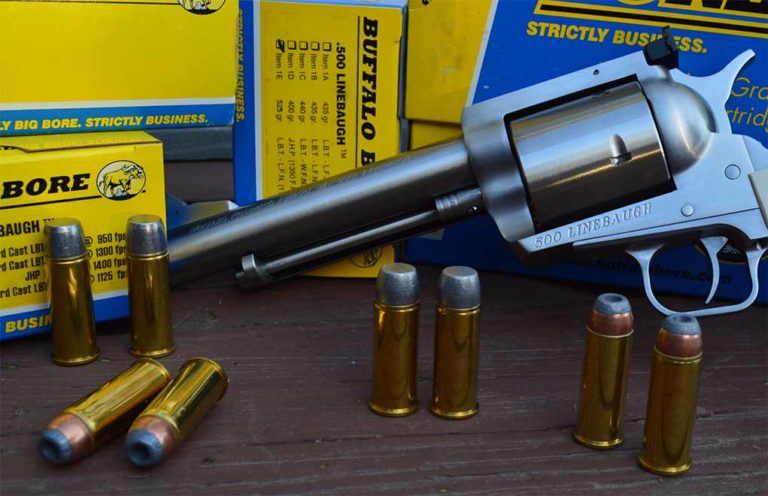
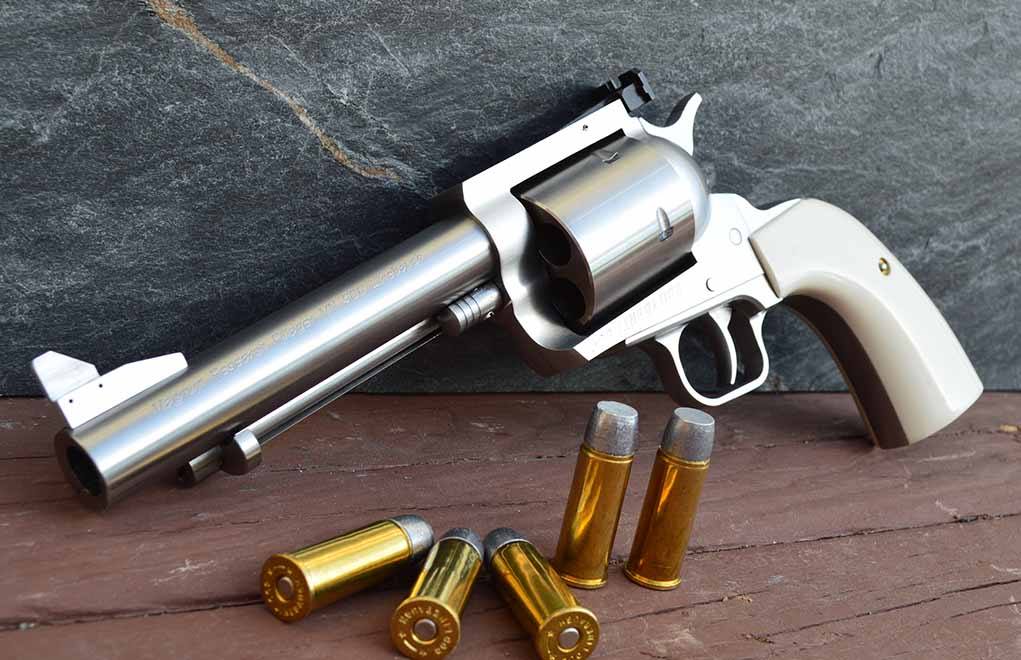
The .500 Linebaugh out of the shadows of obscurity into the light of recognition with the Magnum Research BFR.
How Magnum Research Dishes Up A .500 Linebaugh:
- It's built on Magnum Research’s short-frame and is constructed entirely of 17-4PH stainless steel.
- The oversized, five-shot cylinder is counter-bored and unfluted.
- A free-wheeling pawl enables the cylinder to rotate in either direction with the loading gate open.
- It's equipped with transfer bar systems, allowing for safe carry with a live round under the hammer.
- The revolver sport Magnum Research's interpretation of the Bisley grip frame.
Show up at the range with a .50-caliber handgun, and folks don’t fail to notice. It elicits whispers about compensating for alleged inadequacies and some comments about your mental state. Others secretly hope you bury the front sight in your forehead.
That said, you will not fail to draw attention every time you touch off the behemoth and it thunders the way only a large displacement cartridge can.
But aside from drawing sometimes unwanted attention, what are these big revolvers good for? Big-game hunting, plainly and simply. Well, at least that’s what I use them for!
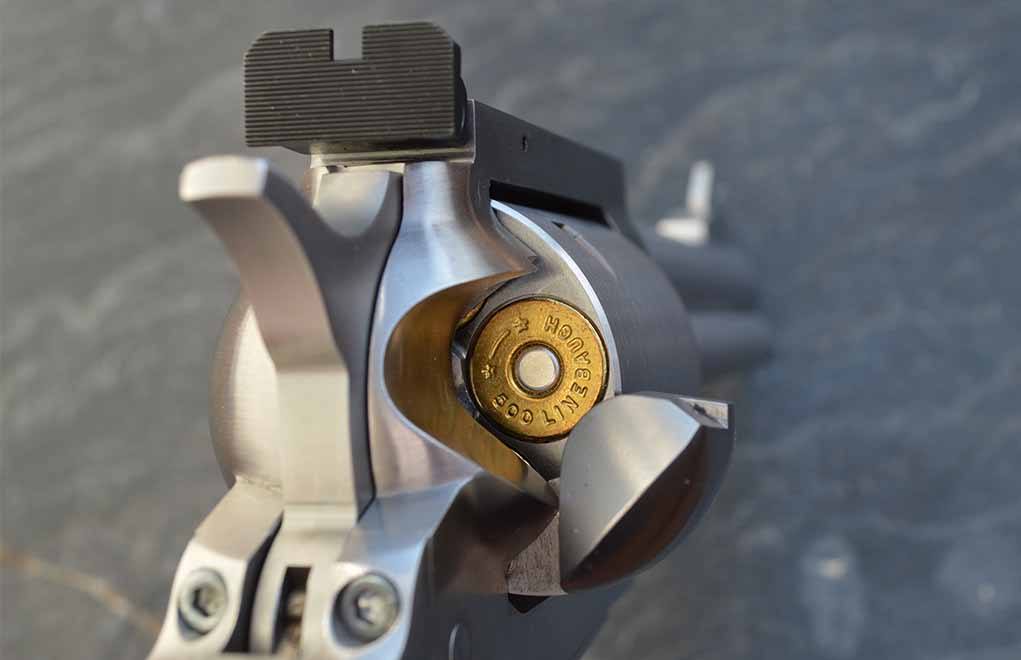
There are a number of .50-caliber handguns readily available commercially that are chambered in .50 AE, .500 JRH, .500 Wyoming Express and the “horsepower king”—the .500 Smith & Wesson Magnum.
However, the .500 Linebaugh has the deepest roots of all. Despite only recently making its commercial debut, having been relegated only to custom builds in more than three decades of existence, we have Magnum Research, manufacturer of the BFR—the “Biggest, Finest Revolver”—to thank for giving .50-caliber aficionados yet another choice.
A Brief History Lesson
Magnum Research’s latest foray into the .50-caliber wars was announced at this year’s SHOT show. However, the .500 Linebaugh was unleashed on the general public in August 1986 by Ross Seyfried. Let’s just say the .500 Linebaugh is “fashionably late.”
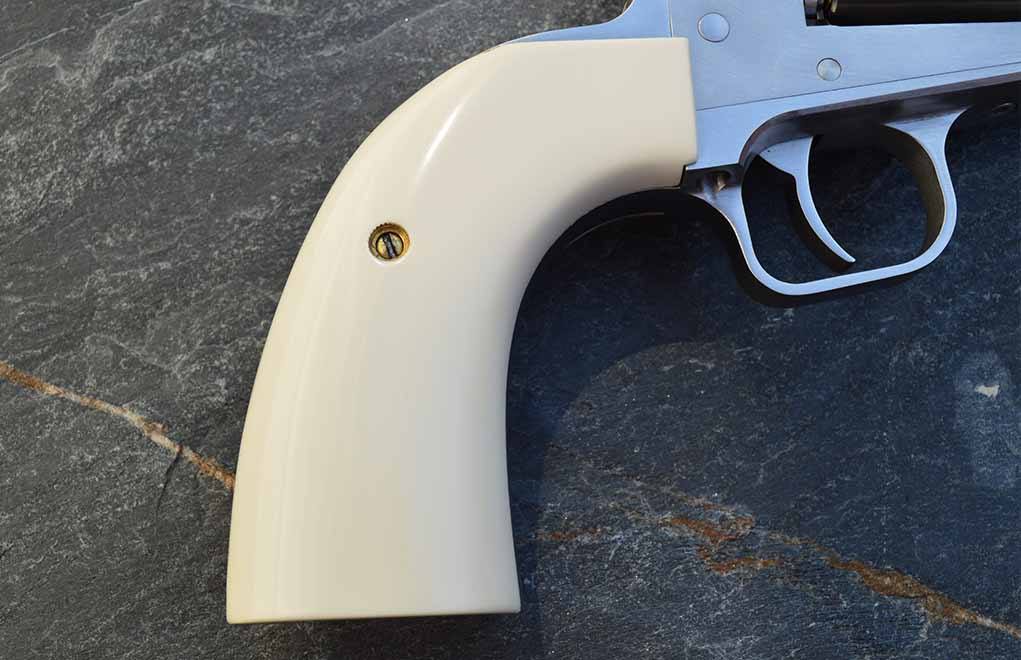
In the mid-1980s, John Linebaugh, a then little-known gun builder out of Cody, Wyoming, created this cartridge in his lab like a mad scientist—using a cut-down .348 case as the “parental unit.” An earlier iteration existed, but the progenitors of that .50-caliber—Bill Topping and Neil Wheeler (out of Salt Lake City, Utah)—were unable to gain any traction, and their creation was stillborn.
So, John Linebaugh used the large-rimmed .348 Winchester, cutting it down to 1.4 inches and blowing the case out to a .510 bore. It was never quite loaded to potential in the early days and was overshadowed by its over-achieving little brother: the .475 Linebaugh, which was another one of Linebaugh’s creations.
For more than three decades, the .500 Linebaugh has been a custom proposition only, typically built on massaged Ruger full-sized, single-action revolvers that cost a premium to construct … until Magnum Research boldly went where no other gun manufacturer has gone before.
Magnum Research BFR
Like all BFRs, this one, built on Magnum Research’s short-frame, is constructed entirely of 17-4PH stainless steel and is all American made. The massive, oversized, five-shot cylinder is counter-bored and unfluted.
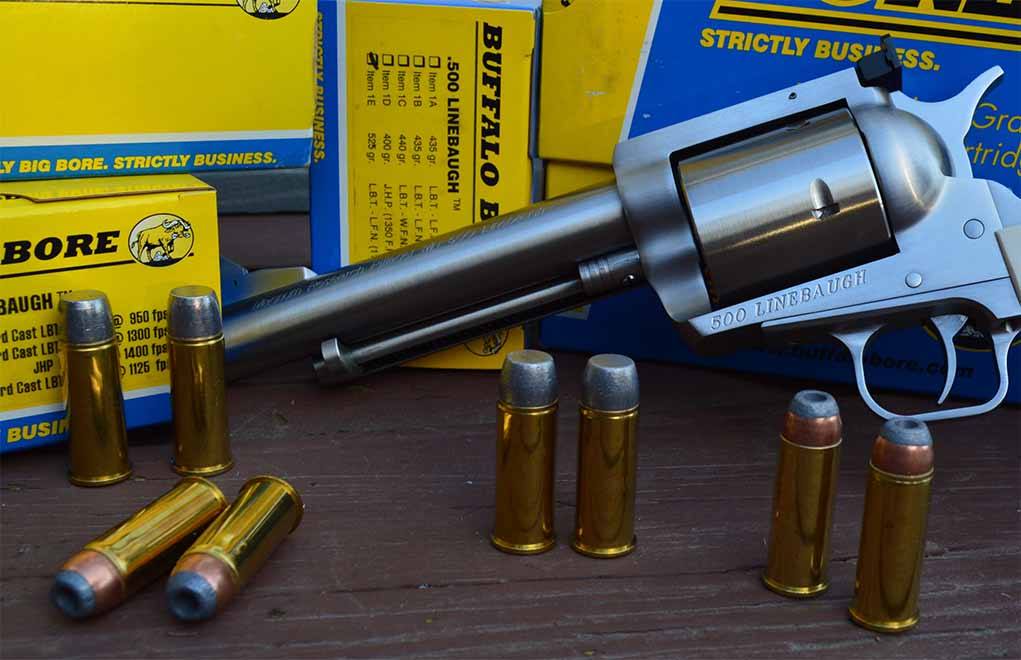
About counter-boring: This is a nice detail that actually serves a precautionary function. Under normal conditions, the cartridge head supports the loading gate and keeps it from tipping forward. If the loading gate encounters an empty hole, it is unsupported and can thereby tip forward a considerable amount. If this happens enough times, a number of failures will result, such as breaking of the loading gate stem and pushing the loading gate spring forward into the thin web of the frame—potentially tearing it (which is permanent damage).
However, counter-boring puts a permanent support in position relative to the loading gate that is not dependent upon loaded cartridge case heads for support. This is particularly important when heavy recoil levels are the norm (not so much with lighter calibers).
The .500 Linebaugh requires a large cylinder to encapsulate it, particularly because of its really big rim. The cylinder rides in the frame on a locking base pin. The free-wheeling pawl is a great feature that enables the cylinder to rotate in either direction with the loading gate open. BFRs are also equipped with transfer bar systems, allowing for safe carry with a live round under the hammer—an important feature when out in the field.
A match-grade barrel is attached to the frame and is adorned with a tall front sight. An LPA adjustable rear sight rounds out the sighting system. But, for the optically challenged, the BFR comes pre-drilled and tapped for a scope base that’s included with the revolver, making it a snap to mount an optic.

Let’s also talk grip frames, because they matter. For years, my only complaint about the BFR was the availability of only one type of grip frame—a plow handle or traditional single-action-type grip. While this is fine for light-recoil-producing cartridges, it’s less than ideal when recoil picks up to the level of Ouch—that hurts!
Magnum Research addressed this issue with the introduction of its own interpretation of the Bisley grip frame, which was originally introduced by Colt way back when. It’s a bit strange-looking (it resembles a banana), but this is where the similarity to that particular fruit ends. This is the best grip frame commercially available for controlling heavy recoil—bar none. This grip frame flat out works! It’s available with ivory polymer or black Micarta grips that are hand fitted. Mine came equipped with attractive ivory polymer. The trigger broke cleanly at 2½ pounds … just the way I like it.
Hard-Punching Performance
I shot this revolver as is quite a bit before I equipped it with an optic that has long been my go-to for hunting duty: an Ultradot 30 red-dot sight.
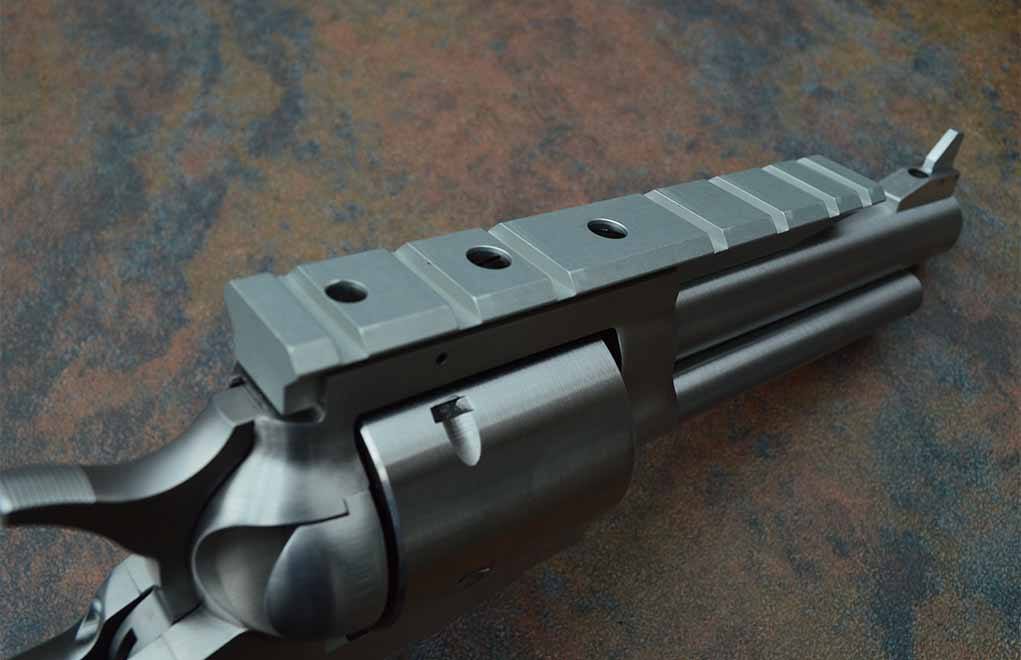
I visited the FTW Ranch in Barksdale, Texas, with my .500 Linebaugh BFR in hand. I sighted in with Buffalo Bore’s 350-grain JHP load in order to run the FTW Ranch’s SAAM (Sportsman’s All-Weather All-Terrain Marksmanship) Safari Training course. You read that right—I was going to run a safari training course with a short-barreled revolver. I had a blast, and the training staff at FTW was delighted with the effectiveness of the short gun on its much-vaunted course.
I was also able to do a little hunting on its 12,000-acre ranch, where I took a beautiful fallow deer with one 350-grain Buffalo Bore jacketed hollow-point. One and done.
When it was time to test the BFR for accuracy, I swapped the red-dot for a fixed 2x Leupold scope, mounted with Leupold quick-detach rings on the factory base. I obtained three different loads from Buffalo Bore Ammunition; it’s the first company to ever offer ammunition for the .500 Linebaugh. The three loads consisted of a light-recoiling 435-grain hardcast, flat-nosed load rated at 950 fps; a 350-grain jacketed hollow-point (JHP) load rated at a lofty 1,550 fps; and a heavyweight, 525-grain hardcast load at a modest 1,125 fps. From an accuracy standpoint, the BFR did not disappoint (see the accuracy results table above).
As I’ve already mentioned, for me, .50-caliber handguns are in their element when hunting big game. That fallow deer fell easily to the big BFR, which will be heading to the game fields again soon. Some will argue “overkill,” but I will submit that there are no degrees of “dead.” Better “overkill” than “barely adequate” in my humble opinion.
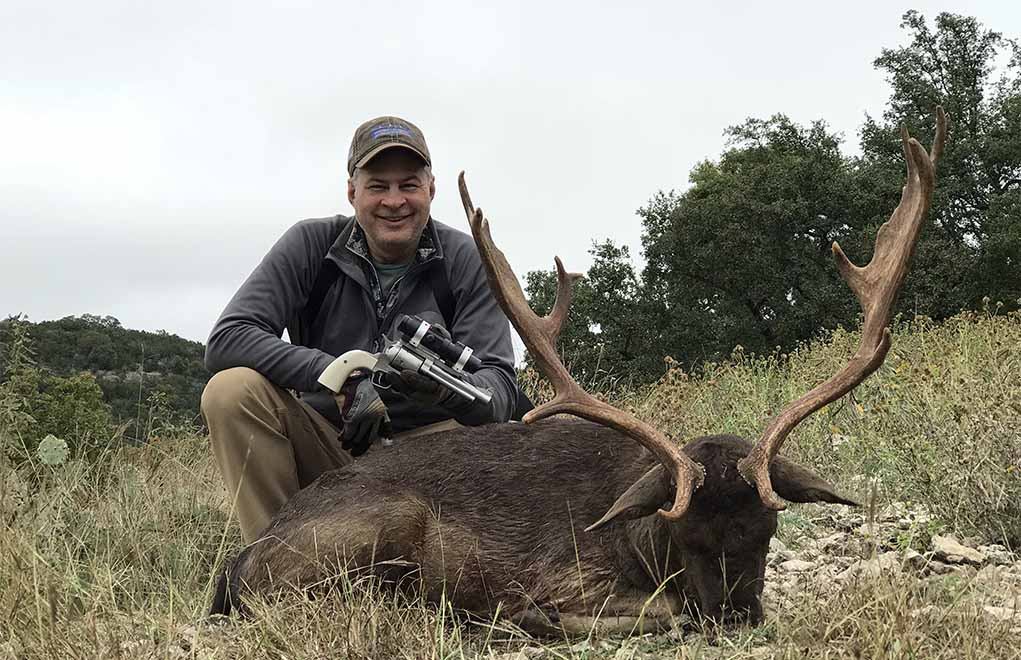
I have used a number of .50-caliber handguns on all manner of game, including the .500 Linebaugh on a custom platform on black bear and moose, so I am very familiar with its terminal effectiveness.
That said, if it’s loaded correctly, I wouldn’t hesitate to use this caliber on virtually any big-game animal that walks the face of the Earth. There is more versatility in these big .50s than one might realize. There is enough case capacity for lighter-jacketed expanding bullets to be pushed to fairly high velocities (by revolver standards), making them ideal for deer-sized game. By default, a .510 diameter will make a large hole in flesh; so, loaded with monolithic solids or Kodiak Punch bullets, it will bring the .500 Linebaugh into the realm of pachyderm.
A .500 Linebaugh BFR might be a great addition to your battery, even if you don’t handgun hunt. However, keep in mind that there are some drawbacks to such powerful chamberings—in particular, the heavy recoil associated with .50-cals, unless you download them to more sedate levels. They kick pretty hard and are able to produce flinches in even the most experienced shooters if they don’t approach familiarization with some modicum of caution. Limiting time on the bench and the number of rounds fired per session are good ways to get familiar—and, dare I say, comfortable—with your new BFR.
So, there you have it. It took 33 years, but here it is, in the flesh—er, stainless steel. Magnum Research brought the .500 Linebaugh out of the shadows of obscurity into the light of recognition, where we hope shooters and hunters, alike, discover its charms and attributes. It’s a little late to the party, but it’s looking good!
Editor's Note: This article is an excerpt from the June 2019 issue of Gun Digest the Magazine.

Next Step: Get your FREE Printable Target Pack
Enhance your shooting precision with our 62 MOA Targets, perfect for rifles and handguns. Crafted in collaboration with Storm Tactical for accuracy and versatility.
Subscribe to the Gun Digest email newsletter and get your downloadable target pack sent straight to your inbox. Stay updated with the latest firearms info in the industry.

![Best Concealed Carry Guns In 2025 [Field Tested] Wilson Combat EDC X9S 1](https://gundigest.com/wp-content/uploads/Wilson-Combat-EDC-X9S-1-324x160.jpg)


![Best 9mm Carbine: Affordable PCCs [Tested] Ruger Carbine Shooting](https://gundigest.com/wp-content/uploads/Ruger-Carbine-Shooting-100x70.jpg)
![Best AR-15: Top Options Available Today [Field Tested] Harrington and Richardson PSA XM177E2 feature](https://gundigest.com/wp-content/uploads/Harrington-and-Richardson-PSA-XM177E2-feature-100x70.jpg)
